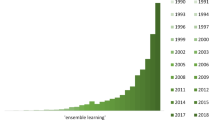Abstract
As deep learning (DL) is evolving rapidly, implementing the knowledge of DL into various fields of human life and the effective usage of existing data insights are becoming crucial tasks for a majority of DL models. We are proposing to ensemble maximum prediction probabilities of different epochs and the epoch which achieved the highest accuracy for classification problems. Our suggestion contributes to the improvement of DL models using the pre-trained and skipped results from epochs. The maximum prediction probability ensemble of epochs increases the prediction space of the entire model if the intersection of prediction scope of any epoch is smaller than the one that has the biggest prediction scope. Using only the best epoch’s prediction probabilities for classification cannot use the other epochs’ knowledge. To avoid bias in this research, a simple CNN architecture with batch normalization and dropout was used as a base model. By ensembling only maximum prediction probabilities of different epochs, we managed to use 50% of the lost data insight from the epochs, thereby increasing the total accuracy by 4–5%.
Access this chapter
Tax calculation will be finalised at checkout
Purchases are for personal use only
Similar content being viewed by others
References
Krawczyk, B., Minku, L.L., Gama, J., Stefanowski, J., Woźniak, M.: Ensemble learning for data stream analysis: a survey. Inf. Fusion 37, 132–156 (2017)
Olimov, B., Kim, J., Paul, A.: REF-Net: robust, efficient, and fast network for semantic segmentation applications using devices with limited computational resources. IEEE Access 9, 15084–15098 (2021)
Yu, L., Wang, S., Lai, K.K.: Credit risk assessment with a multistage neural network ensemble learning approach. Exp. Syst. Appl. 34(2), 1434–1444 (2008)
Zhao, Y., Li, J., Yu, L.: A deep learning ensemble approach for crude oil price forecasting. Energy Econ. 66, 9–16 (2017)
Khamparia, A., et al.: A novel deep learning-based multi-model ensemble method for the prediction of neuromuscular disorders. Neural Comput. Appl. 32(15), 11083–11095 (2018)
Chen, Y., Wang, Y., Gu, Y., He, X., Ghamisi, P., Jia, X.: Deep learning ensemble for hyperspectral image classification. IEEE J. Select. Top. Appl. Earth Observ. Remote Sens. 12(6), 1882–1897 (2019)
Qummar, S., et al.: A deep learning ensemble approach for diabetic retinopathy detection. IEEE Access 7, 150530–150539 (2019)
Galicia, A., Talavera-Llames, R., Troncoso, A., Koprinska, I., Martínez-Álvarez, F.: Multi-step forecasting for big data time series based on ensemble learning. Knowl. Based Syst. 163, 830–841 (2019)
Zhou, T., Lu, H., Yang, Z., Qiu, S., Huo, B., Dong, Y.: The ensemble deep learning model for novel COVID-19 on CT images. Appl. Soft Comput. 98, 106885 (2021)
Sarmadi, H., Entezami, A., Saeedi Razavi, B., Yuen, K.V.: Ensemble learning-based structural health monitoring by Mahalanobis distance metrics. Struct. Control Health Monitor. 28(2) (2021)
Chen, Z., Duan, J., Kang, L., Qiu, G.: Class-imbalanced deep learning via a class-balanced ensemble. IEEE Trans. Neural Netw. Learn. Syst. 1–15 (2021)
Xiao, Y., Wu, J., Lin, Z., Zhao, X.: A deep learning-based multi-model ensemble method for cancer prediction. Comput. Methods Prog. Biomed. 153, 1–9 (2018)
Sagi, O., Rokach, L.: Ensemble learning: a survey. WIREs Data Mining Knowl. Discov. 8(4) (2018). https://doi.org/10.1002/widm.1249.
Author information
Authors and Affiliations
Editor information
Editors and Affiliations
Rights and permissions
Copyright information
© 2021 Springer Nature Switzerland AG
About this paper
Cite this paper
Musaev, J., Nguyen, N.T., Hwang, D. (2021). EMaxPPE: Epoch’s Maximum Prediction Probability Ensemble Method for Deep Learning Classification Models. In: Wojtkiewicz, K., Treur, J., Pimenidis, E., Maleszka, M. (eds) Advances in Computational Collective Intelligence. ICCCI 2021. Communications in Computer and Information Science, vol 1463. Springer, Cham. https://doi.org/10.1007/978-3-030-88113-9_23
Download citation
DOI: https://doi.org/10.1007/978-3-030-88113-9_23
Published:
Publisher Name: Springer, Cham
Print ISBN: 978-3-030-88112-2
Online ISBN: 978-3-030-88113-9
eBook Packages: Computer ScienceComputer Science (R0)




